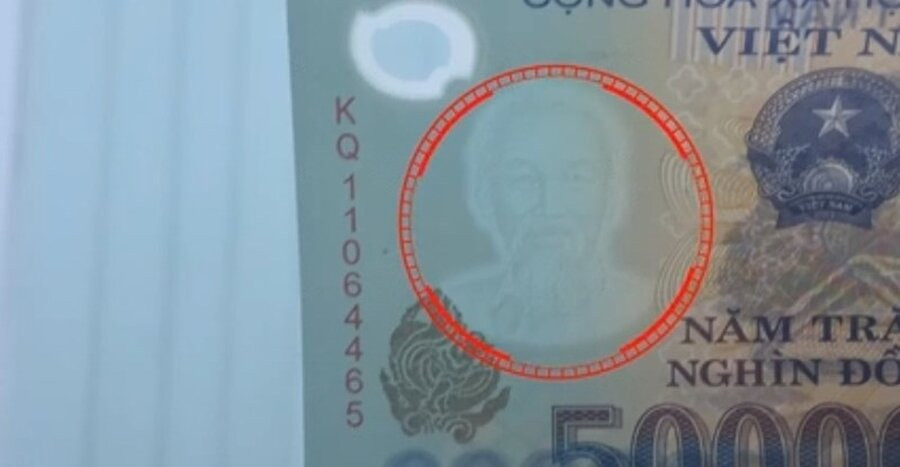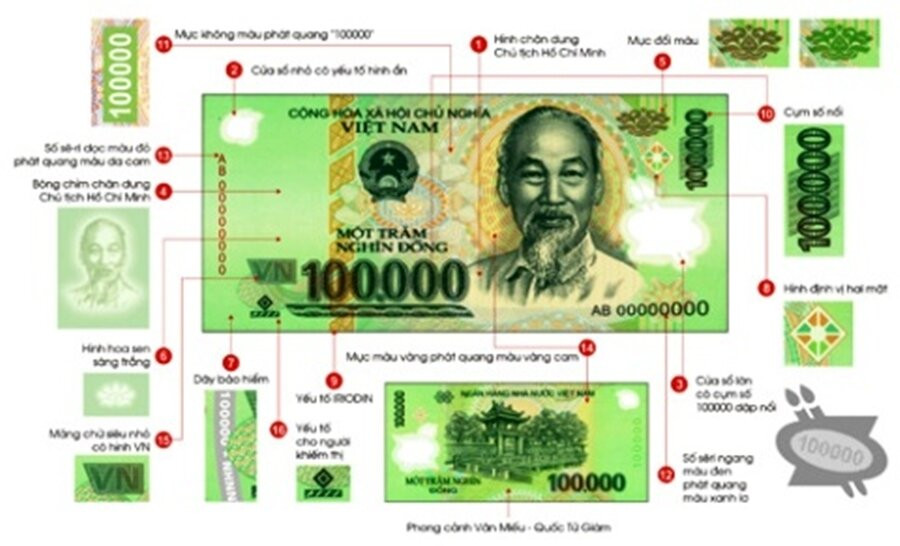To avoid risks, people need to know some of the most effective ways to distinguish fake money from real money with the naked eye.

People can visually distinguish real money from fake money. (Illustration photo)
Check the polymer material used to print money
Real money is printed on polymer material, which has high elasticity and durability. Therefore, people can check the elasticity by holding the bill in the palm of their hand and when opened, the bill will return to its original state. In addition, the durability can be checked by pulling and tearing the edge of the bill lightly (be careful not to pull or tear the bill in the torn position), real money will be difficult to tear and stretch.
Meanwhile, counterfeit money is mainly printed on nylon, so it does not have the characteristic elasticity and durability of real money. If you hold a counterfeit bill in the palm of your hand and open it, the bill will not return to its original state. When pulling or tearing the edge of the bill, it will easily stretch or tear.
Hold the bill up to a light source.
According to authorities, holding the bill up to a light source will help identify and check the watermark, security thread and locator pattern.
Shadow(left front or right back of the bill): users can clearly see from both sides of the bill, shown with many delicate and bright white lines. With denominations from 20,000 to 500,000 VND is a portrait of President Ho Chi Minh; with denominations of 10,000 VND is an image of the One Pillar Pagoda.
Positioning image: For 10,000 VND and 20,000 VND bills, it is on the upper left side of the front or upper right side of the back of the bill. For 50,000 - 500,000 VND bills, it is on the upper right side of the front or upper left side of the back of the bill. When examined, the images on both sides will fit together, forming a complete image, with even white spaces.
If it is a counterfeit, the watermark is just a simulated image, not sophisticated; the positioning image does not fit tightly, the white slots are uneven.
Safety rope: When examined, you will clearly see from both sides, running along the banknote, the denomination number and the words “NHNNVN” (or “VND” - denomination 10,000 VND) shining white. For example, on a banknote with a denomination of 50,000 VND, the security thread is interrupted, with the number “50000”.
Gently stroke the front of the bill, checking the embossed elements.
In places with embossed elements, when touched, you will feel the raised, roughness of the print, such as: Portrait of President Ho Chi Minh, National emblem, denomination in numbers and words, the words "SOCIALIST REPUBLIC OF VIETNAM". Meanwhile, counterfeit money only feels smooth, or has a rough feeling due to the embossing on the paper background, without the raised, roughness of real money.
Tilt the note, check for color changing ink (OVI), iriodin strip
The color-changing ink is only available on the three denominations of 500,000, 200,000 and 100,000 VND. The 500,000 and 200,000 VND notes are on the bottom left; the 100,000 VND note is on the top right of the front of the note. When tilting the note and observing, the color-changing ink will change from yellow to green or vice versa.
The iriodin strip is only found on the 500,000, 200,000, 100,000, 20,000 and 10,000 VND notes. This is a yellow strip running along the back of the note, while the 100,000 VND note is on the front of the note. When tilting the note, you will see a metallic iriodin strip, with a denomination number or pattern on the strip.
Counterfeit money has the OVI element but does not change color, or changes color but is not the same color as on genuine money, does not have the iriodin stripe or has the printing but does not sparkle like on genuine money.

(Photo: SBV)
Check hidden image (DOE) in small window
The small window is only available in 4 denominations of 500,000, 200,000, 100,000 and 50,000 VND. This is a transparent plastic background detail and is located at the top left of the front or top right of the back of the bill. When you bring the small window close to your eyes, look through the window to a suitable light source (can be a flame, incandescent bulb, street light, phone flash) you will see an image appear around the light source.
In older bills, the small window often has many scratches, affecting the quality of the image. In counterfeit bills, there is no hidden image element in the small window.
Use a magnifying glass and ultraviolet light to check microprints.
In addition to observing with the naked eye, we can distinguish real money from fake money with a magnifying glass or ultraviolet light. Accordingly, the micro-printed letters are created by the repeated lines of words “NHNNVN” or “VN” or numbers with denominations, clearly visible under a magnifying glass.
Fluorescent colorless ink: Is a cluster of denomination numbers printed with colorless ink, only visible (fluorescent) when viewed under ultraviolet light.
Luminescent serial numbers: Vertical red serial numbers fluoresce orange and horizontal black serial numbers fluoresce blue when viewed under UV light.
Counterfeit money does not have microscopic letters or lines of letters and numbers that are not sharp and difficult to read. Counterfeit money also does not have colorless fluorescent ink or if it is counterfeited, it will glow weakly. Serial numbers do not glow or glow differently than real money.
According to VTC News